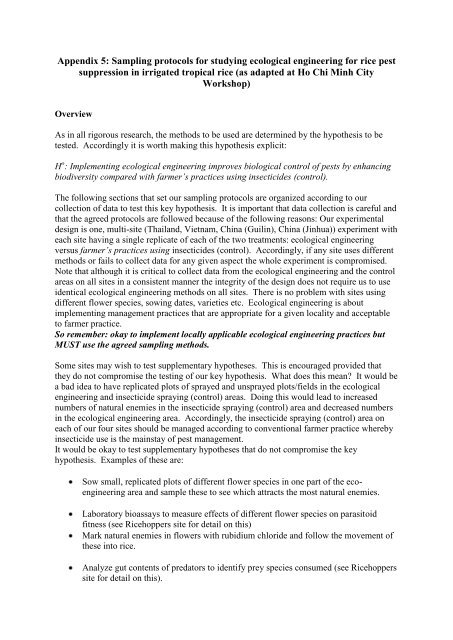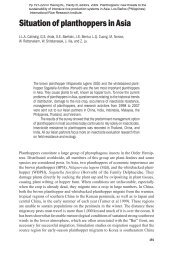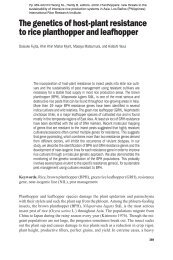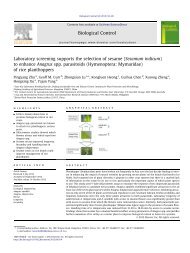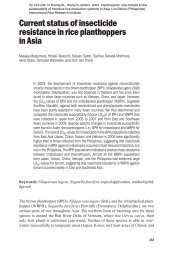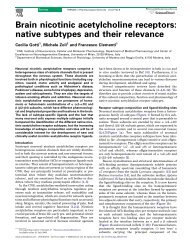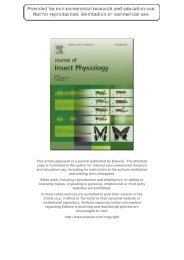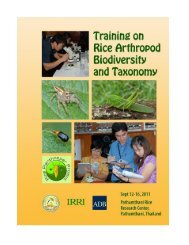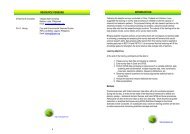Final Report Appendix 5 (Ho Chi Minh City Revised ... - Ricehoppers
Final Report Appendix 5 (Ho Chi Minh City Revised ... - Ricehoppers
Final Report Appendix 5 (Ho Chi Minh City Revised ... - Ricehoppers
You also want an ePaper? Increase the reach of your titles
YUMPU automatically turns print PDFs into web optimized ePapers that Google loves.
<strong>Appendix</strong> 5: Sampling protocols for studying ecological engineering for rice pest<br />
suppression in irrigated tropical rice (as adapted at <strong>Ho</strong> <strong>Chi</strong> <strong>Minh</strong> <strong>City</strong><br />
Workshop)<br />
Overview<br />
As in all rigorous research, the methods to be used are determined by the hypothesis to be<br />
tested. Accordingly it is worth making this hypothesis explicit:<br />
H o : Implementing ecological engineering improves biological control of pests by enhancing<br />
biodiversity compared with farmer’s practices using insecticides (control).<br />
The following sections that set our sampling protocols are organized according to our<br />
collection of data to test this key hypothesis. It is important that data collection is careful and<br />
that the agreed protocols are followed because of the following reasons: Our experimental<br />
design is one, multi-site (Thailand, Vietnam, <strong>Chi</strong>na (Guilin), <strong>Chi</strong>na (Jinhua)) experiment with<br />
each site having a single replicate of each of the two treatments: ecological engineering<br />
versus farmer’s practices using insecticides (control). Accordingly, if any site uses different<br />
methods or fails to collect data for any given aspect the whole experiment is compromised.<br />
Note that although it is critical to collect data from the ecological engineering and the control<br />
areas on all sites in a consistent manner the integrity of the design does not require us to use<br />
identical ecological engineering methods on all sites. There is no problem with sites using<br />
different flower species, sowing dates, varieties etc. Ecological engineering is about<br />
implementing management practices that are appropriate for a given locality and acceptable<br />
to farmer practice.<br />
So remember: okay to implement locally applicable ecological engineering practices but<br />
MUST use the agreed sampling methods.<br />
Some sites may wish to test supplementary hypotheses. This is encouraged provided that<br />
they do not compromise the testing of our key hypothesis. What does this mean? It would be<br />
a bad idea to have replicated plots of sprayed and unsprayed plots/fields in the ecological<br />
engineering and insecticide spraying (control) areas. Doing this would lead to increased<br />
numbers of natural enemies in the insecticide spraying (control) area and decreased numbers<br />
in the ecological engineering area. Accordingly, the insecticide spraying (control) area on<br />
each of our four sites should be managed according to conventional farmer practice whereby<br />
insecticide use is the mainstay of pest management.<br />
It would be okay to test supplementary hypotheses that do not compromise the key<br />
hypothesis. Examples of these are:<br />
Sow small, replicated plots of different flower species in one part of the ecoengineering<br />
area and sample these to see which attracts the most natural enemies.<br />
Laboratory bioassays to measure effects of different flower species on parasitoid<br />
fitness (see <strong>Ricehoppers</strong> site for detail on this)<br />
Mark natural enemies in flowers with rubidium chloride and follow the movement of<br />
these into rice.<br />
Analyze gut contents of predators to identify prey species consumed (see <strong>Ricehoppers</strong><br />
site for detail on this).
We plan to seek additional funding to develop molecular (DNA ‘barcoding’) identification<br />
methods for natural enemies captured in this project so you will notice later sections specify<br />
use of 100% ethanol for specimen storage. This will maximize DNA quality and is especially<br />
important for samples collected by sweep net and for parasitoids reared from egg trap plants<br />
because these specimens can be placed immediately into preservative without any<br />
degradation.<br />
Sampling methods for key hypothesis<br />
H o : Implementing ecological engineering improves biological control of pests by enhancing<br />
biodiversity compared with farmer’s practices using insecticides (control).<br />
Testing this hypothesis will require staff at each of the four sites to collect data from their<br />
ecological engineering area and the farmer’s practices using insecticides (control) area in<br />
following manner.<br />
Sampling in the two areas should be with the same equipment, using the same staff and as far<br />
as possible on the same day and approximately the same time of the day so that any<br />
differences between the two experimental treatments is attributable to the treatments and not<br />
an artifact of sampling.<br />
The sampling methods outlined below should be used in the approximate centre of rice fields<br />
(i.e. at least 10m from the field margin) and near the rice bunds (i.e. about 1m from the<br />
bunds) and from 10 fields in the ecological engineering and 10 fields in the farmer practice<br />
with insecticide spray (control) areas. Sampling by different methods should not be done on<br />
the same point, which was sampled before using another method (refer to sampling lay out).<br />
If different varieties have been sown in each of these areas (or there is some other difference<br />
such as fertilizer use/ sowing date/ irrigation etc) then fields should be matched as far as<br />
possible so that there is a ‘like for like’ field in the ecological engineering and farmer practice<br />
with insecticide spray (control) areas.<br />
For 10 fields in the ecological engineering and 10 fields in farmer practice with insecticide<br />
spray (control) take sample at the seedling, tillering, booting and milking stages of rice<br />
growth (i.e. samples at each of the four major growth stages) (refer to the general rice growth<br />
stages illustrated below) using the following methods:<br />
Yellow sticky trap (three traps mounted on wooden stakes to be just above the crop<br />
canopy with 5 meters distance between traps installed at the center of the rice field<br />
and near the rice bund, collected after 24 hr). There will be one hundred twenty<br />
samples for each sampling period.<br />
Yellow pan trap (three traps mounted on stand at approximately the same height of<br />
vegetation or just below the canopy level with 5 meters distance between traps at the<br />
center of the rice field and near the rice bund, left in place for 24 hr). There will be<br />
one hundred twenty samples for each sampling period.<br />
Blower-vac sampler (single sample from an undisturbed part of the center of the field<br />
and near the rice bund). There will be forty samples for each sampling period.
Sweep net (30 sweeps whilst walking slowly through an undisturbed part of the center<br />
of the field at approximately 0.5 m/sec and 30 sweeps on the rice hills at least 1m<br />
from the rice bunds). There will be forty samples for each sampling period.<br />
All the sampling methods should be used at the center part of the rice fields as well as close<br />
to (about 1 m) the rice bunds.<br />
In addition to sampling on different growth stages of the rice crop, take sample of parasitoids<br />
during peak abundance of planthoppers (this will be determined based on the population of<br />
hoppers from blow-vac and sweep net samplings) using bait trap method.<br />
Bait traps for egg parasitism (one bait plant with BPH eggs on the center and one near<br />
(1 m) from the rice bund for each field) will be carried out in 5 fields in the ecological<br />
engineering and 5 fields in farmer practice with insecticide spray (control) at peak<br />
time of each generation of rice planthoppers. The trappings will be done 2-3 times for<br />
each site. There will be twenty samples for each sampling day.<br />
Additional method is the use of sticky plate to count the number of hoppers per unit area.<br />
This will be done once every week for the 10 ecological engineering fields and 10 fields in<br />
farmer practice with insecticide spray (control).<br />
Further detail on each of these methods is set out later in this document.<br />
100-day variety<br />
Vegetative phase<br />
Reproductive phase<br />
Ripening phase<br />
(35 days) (35 days) (30 days)<br />
Tillering<br />
Panicle initiation Flowering Mature grain<br />
120-day variety<br />
Vegetative phase<br />
Reproductive phase<br />
Ripening phase<br />
(55 days) (35 days) (30 days)<br />
0 10 20 30 40 50 60 70 80 90 100 110 120<br />
Tillering<br />
Panicle initiation Flowering Mature grain<br />
Days from sowing<br />
Sampling schedule:<br />
General rice growth stages
1. Direct seeded rice<br />
Seedling stage: 2-3 weeks after seeding<br />
Tillering stage: 5-6 weeks after seeding<br />
Booting stage: 8-9 weeks after seeding<br />
Milking stage: 10-12 weeks after seeding<br />
2. Transplanted rice<br />
Seedling stage: about 2 weeks after transplanting<br />
Tillering: 4-5 weeks after transplanting<br />
Booting: 8-9 weeks after transplanting<br />
Milking: 11-14 weeks after transplanting<br />
Rice bund
Sampling lay out of different methods in one field<br />
Sweep net (which is about 15 m long covering 30 sweeps)<br />
Yellow sticky trap<br />
Yellow pan trap<br />
Egg bait trap<br />
Blow-vac machine<br />
Taxonomy and identification<br />
Arthropod biodiversity may be studied through sampling, counting and identifying the<br />
specimens. Wherever identification to named species is not possible, individuals should be<br />
identified to ‘morphospecies’ (otherwise known as recognizable taxonomic unit). This means<br />
that specimens are sorted into categories in which all individuals are identical. For example<br />
‘Ichneumonid #1 or Coccinellid # 3). Bulk, unsorted samples are best stored in 70-100%<br />
alcohol allow follow up identification. (Scope for DNA barcoding is being investigated?).<br />
All the predator specimens should be sorted as early as possible and preserved in 100 %<br />
ethanol for further testing. Scrupulous attention needs to be paid to labeling such bulk<br />
samples and individual specimens (e.g. date collected, site, exact position or plot number if<br />
from within an experiment, collector’s name are the minimum).<br />
Several sampling techniques are to be used in the overall IRRI/ADB project.<br />
Yellow sticky trap<br />
Yellow sticky trap is designed to attract a variety of insects. The yellow color of the trap<br />
attracts the insects and the sticky coating captures them. Its dimension is 28.5 cm x 10.5 cm.<br />
A flat bar metal frame holds the yellow sticky strap and its base is attached to a conduit pipe,<br />
which is then inserted into a rounded PVC pipe. Both pipes are with holes for easy adjusting<br />
during the different growth stages of the rice plant.<br />
Sampling by yellow sticky trap<br />
1. Install the yellow sticky trap just above the rice canopy for 24 hours.<br />
2. Retrieve the trap after 24 hours.<br />
3. Cover the sticky trap with a transparent plastic sheet after retrieval.<br />
4. Slice or cut the trap longitudinally into 2-3 parts for easy handling under the<br />
microscope.<br />
5. Identify the natural enemies that sticked on the traps.<br />
6. Keep the yellow sticky trap refrigerated if identification is to be delayed. Do the<br />
sampling on seedling, tillering, booting, and milking stages of the rice crop.<br />
7. The standardized sticky trap will be provided by Dr Lv.<br />
8. Do the sampling on seedling, tillering, booting, and milking stages of the rice crop.
10.5 cm<br />
28.5 cm<br />
Flat bar metal frame<br />
(1/8 x ¼ inch)<br />
.<br />
Conduit pipe with holes<br />
(1/2 inch diameter)<br />
PVC pipe (plastic)<br />
(3/4 inch diameter)<br />
Yellow pan trap<br />
Many small day-active insects are attracted to the color yellow. Yellow pan traps collect<br />
insects that are attracted to the color. They are inexpensive and simple means of passively<br />
sampling insects in an area. This trapping method uses small pans filled with a mixture of<br />
water and liquid detergent. The pans are then placed on the ground in conspicuous places in<br />
the morning. When flying insects land on the surface of the water they rapidly sink and<br />
drown. At the end of the day or after 1-2 days, the water is strained through a fine sieve and<br />
the specimens are collected.<br />
Sampling arthropods by yellow pan trap<br />
1. Use 500 ml circular plastic ‘take away food container’ (with 17 cm diameter and 5 cm<br />
depth). Deeper bowls experience less evaporation in hot climates.<br />
2. Cut one hole near top of bowl and cover with mesh. In excessive rain this allows<br />
water to flow out of the bowl without losing any samples.<br />
3. Paint with two top coats of yellow UV paint (e.g. RJ London acrylic spray paint).<br />
4. Place bowls at approximately the same height of vegetation (50-100 cm) or just below<br />
the canopy level using a wire frame.<br />
5. Add a mixture of 400 ml water and 1.2 g of sodium benzoate preservative and one<br />
drop of liquid detergent (washing-up liquid).<br />
6. Cover each bowl with a coarse wire mesh to prevent scavanging of insects by birds.<br />
7. Leave out for 24 hrs at a time.<br />
8. Use an aquarium net or fine sieve to collect the insects and place in 100 % ethanol.
Yellow pan trap at vegetative stage of the rice crop.<br />
Insect sweep net<br />
The use of sweep net is a simple and inexpensive way to monitor the presence of a variety of<br />
arthropods in the ecosystem. If sampling effort is consistent (e.g. 30 sweeps whilst walking<br />
slowly through vegetation) samples can also be used to infer relative abundance of arthropods<br />
within a vegetation type. The sweep net is a funnel-shaped net, which is made-up of a nylon<br />
or similar synthetic fabric. It is important that the net is mounted on a rigid metal ring rather<br />
than wire. This allows the net to be swept through dense vegetation, dislodging arthropods.<br />
The net’s ring is attached to a long wood or metal handle. A standard sweep net has a<br />
diameter of 28 cm with a length of 71 cm long. The stick handle is about 74 cm long.<br />
28 cm<br />
74 cm<br />
71 cm
<strong>Ho</strong>w to use a sweep net<br />
A typical sweep net<br />
1. <strong>Ho</strong>ld the sweep net near the end of the handle with the hoop end nearest to the ground<br />
in front of you.<br />
2. Swing the net from side to side in a full 180 o arc or forming a semicircle. Keep the<br />
circular frame of the open end of the net perpendicular to the ground and pointing to<br />
the direction of the swing.<br />
3. Sweep one stroke per step as you casually walk through the field or down the row. Do<br />
not swing the net up and down.<br />
4. In short vegetation, swing the net as deeply as possible.<br />
5. In taller vegetation, sweep only deeply enough to keep upper edge of the sweep net<br />
opening even with the top of the plants.<br />
6. The net should not go more than 25 cm below the top of the plants during sampling.<br />
Sampling arthropods by a sweep net<br />
1. Sampling must be done when all the morning dew has evaporated. Avoid sampling in<br />
raining and wet weather.<br />
2. Do thirty sweeps on the center of the field and another thirty sweeps on the rice hills<br />
next to the bunds or about 1 m from the bunds.<br />
3. Swing the net as hard as possible after the last sweep. This will allow the insects to be<br />
deposited at the funnel end of the net.<br />
4. Close the net by gripping the mid section by the palm.<br />
5. Invert the net and put the collected insects in plastic bags and label with tags.<br />
6. Transfer the collected insects in labeled zip loc or plastic bag with 100% ethanol.<br />
7. Bring the zip loc to the laboratory and transfer into labeled vials maintaining the<br />
100% ethanol. Record the time from sampling to transferring into labeled vials.<br />
8. Identify all the insects based on guilds.<br />
9. Do the sampling on seedling, tillering, booting, and milking stages of the rice crop.<br />
Each passage of the net is considered one sweep.
sweep.<br />
<strong>Ho</strong>ld firmly the end of the net after the Invert the net and transfer the insects last<br />
in labeled zip loc or plastic bag.<br />
Transfer all collected insects.<br />
Close the zip loc.<br />
The efficiency of a sweep net may vary depending on many factors. Different weather<br />
conditions, wind speed, air temperature, and intensity of solar radiation may affect the<br />
number of insects in the area while sweeping. Different habitats, especially the height of the<br />
plants, time of day, reflecting different cycles of behavior of the species, and different styles<br />
of sweeping are also factors to be considered.<br />
Blower-vac machine<br />
Blower-vac machine may be used for more quantitative studies of insects in rice. It is<br />
operated by a gasoline-powered motor. The machine sucks the insects from rice plants by<br />
vacuum pressure. This machine is similar to that described by Arida and Heong (1992).<br />
<strong>Ho</strong>wever, instead of a plastic bucket, it will use a plastic bin.<br />
A modified blower-vac apparatus for sampling arthropods. Arrows indicate the flow of air,<br />
water and arthropods through the apparatus. Symbols: (n) new or (m) modified part from
the original blower-vac apparatus.<br />
A<br />
B<br />
(A) A square and (B) a circular sampling enclosure, which can enclose (A) 4 hills or 0.25 m 2 for<br />
transplanted rice and (B) 0.1 m 2 for direct seeded rice, as shown in the above picture, should be<br />
prepared for sampling.<br />
Sampling of arthropods by blower-vac machine<br />
1. To sample using the blower-vac, drop the plastic bin enclosure over the rice plants.<br />
2. Suck the arthropods from the nylon net sleeve, the air column, the plant<br />
surfaces and finally the water surface. The suction time will depend until all the<br />
insects are collected (suction time will later be prolonged as rice crop matures).<br />
3. Place the collected insects in labeled vials with 70% ethanol.<br />
4. Sort and identify all the insects based on guilds as early as possible and all the<br />
predator specimens should be kept in vials with 100% ethanol and store at -18 to<br />
20 o C.<br />
5. Do the sampling on seedling, tillering, booting, and milking stages of the rice crop in<br />
the morning. Avoid sampling during the afternoon.<br />
A blower-vac machine in action in the field.<br />
Bait traps for egg parasitization
Egg trap is special trap used for investigating natural enemies related to egg stage.<br />
1. Use about 30-day-old rice plants susceptible to BPH.<br />
2. Thin the rice plants to 5 tillers each pot.<br />
3. Introduce five gravid female adults to the rice plants for oviposition in the morning.<br />
4. Remove the adults after 24 hours.<br />
5. Bring the plants with newly laid eggs in the morning to the rice field and expose for 72<br />
hours.<br />
6. Retrieve the rice plants with eggs after 72 hours and bring to the greenhouse or laboratory<br />
and cover with a mylar cage for another 3 days.<br />
7. Use a black cloth to cover the cage, but leave a hole with glass tube and light at top to<br />
attract parasitoids after their emergence.<br />
8. Check daily the glass tube for parasitoids and count the number of planthopper nymphs<br />
that emerge. Identify the species and take records.<br />
9. Calculate parasitism rate for each pot, as well as the mean parasitism rate for each area.<br />
10. Do the bait traps at the peak time for each planthopper generation.<br />
Rice plants with eggs ready for field exposition<br />
A wooden stick is pegged on the bait<br />
trap in the field<br />
glass tube
The rice plant is enclosed with a<br />
mylar cage after field exposition.<br />
A black cloth covers the mylar cage<br />
with a glass tube on top for parasitoids.<br />
Counting of hoppers/m2<br />
White enamel plates coated with sticky substance can be used to count the number of hoppers<br />
per hill.<br />
Sampling of hoppers by hill<br />
1. Use a white enamel plate with 30 x 45 cm dimension.<br />
2. Spread kerosene ( or petroleum jelly) or anything sticky on the plate. (Leave a small<br />
space uncoated for easy handling).<br />
3. Position the plate close enough to the base of the rice hills or plants carefully to avoid<br />
agitating the planthoppers and tap the hills several times with the hand to collect the<br />
hopper.<br />
4. For transplanted fields, tap 2 hills at a time and sample 5 times for each field. For direct<br />
seeded fields, use 0.05 m 2 for each sampling and sample 5 times for each field.<br />
5. Bring the plate to the laboratory and count the number of hoppers based on age (young<br />
nymphs from 1 st – 3 rd instars and mature nymphs from 4 th – 5 th instars) and forms (shortwinged<br />
or brachypterous and long-winged or macropterous) that stick to the board.<br />
6. Do the sampling at 7 day intervals.<br />
Sampling of hoppers using an enamel plate.
Evaluating predation quantitatively using triplex RT-PCR<br />
The triplex RT-PCR could be used to evaluate species-specific predation by all the predators<br />
qualitatively and compare relative predation quantitatively for particular predator species<br />
among sites. All the samples taken by the sampling methods mentioned above could be used<br />
for evaluation by the RT-PCR method if the samples could be kept in 100% ethanol.<br />
1. Samples (mainly predators) taken by Blower-vac machine and Insect sweep net<br />
(samples taken each time should be put into a nylon stocking with a label (field<br />
number and sampling date), then keep in bottle with 70% ethyl alcohol in fields as<br />
soon as possible (the longer the samples are kept without ethyl alcohol, the greater the<br />
predation will be and DNA quality will also decline).<br />
2. All the samples should be sorted as early as possible (within a week) and all the<br />
predators are transferred into labeled vials with 100% ethanol by species or groups<br />
after sorting or identification.<br />
3. The vials with predators should be kept in freezer at minus 18-20 o C.<br />
4. Testing. All the samples will be collected before November next year and will be tested<br />
by ZJU.<br />
Identification of arthropod samples from all sampling techniques<br />
1. All the samples should be sorted out first as early as possible (within 1-2 weeks after<br />
sampling) as first step for further identification.<br />
2. All the predator specimens should be kept in labeled vials with 100% ethanol and<br />
should be stored in minus 18-20 o C (for PCR analysis later).<br />
3. Sort, count and identify the collected arthropods to species level (if possible).<br />
4. Group the sampled arthropods based on guilds (predators/omnivores and<br />
parasitoids/parasites) described by Moran and Southwood (1982).<br />
Data analysis<br />
1. The raw data will be entered into Excel file using a standardized data sheet (refer to<br />
attachment).<br />
2. Analysis will follow.<br />
References:<br />
Arida GS, Heong KL. 1992. Blower-Vac: a new suction apparatus for sampling rice<br />
arthropods. International Rice Research Newsletter 17(6):30-31.<br />
Moran VC, Southwood TRE. 1982. The guild composition of arthropod communities in trees.<br />
J. Animal Ecol. 51:289-306.


